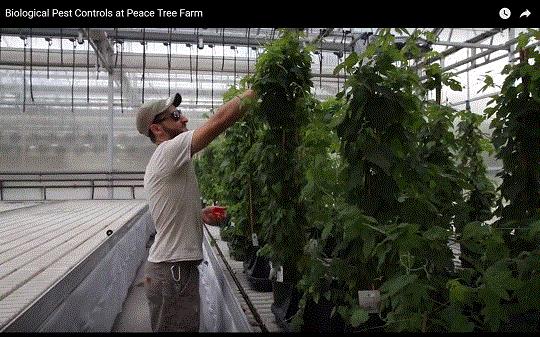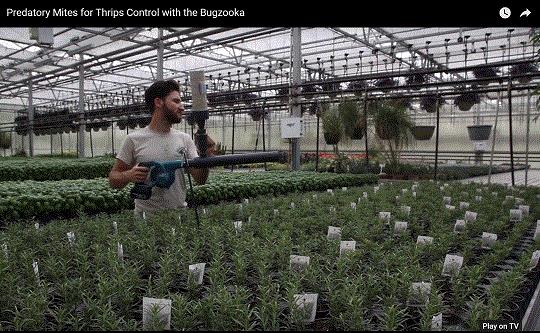Farm Bill Finale
My colleague and partner in crime (not literally) Jen Zurko put together this rundown on what you need to know about the Farm Bill’s passage:
On Wednesday, December 12, 2018, Congress passed the new version of the Farm Bill in a swift bipartisan vote.
The Senate voted 87-13 on Tuesday the 11th, while the House passed the legislation by a 369-47 vote Wednesday afternoon. As of press time, the bill was awaiting the President’s signature to be enacted into law. When signed, the provisions in the new Farm Bill will be in effect until 2023.

The main question is: What’s in it for hort? There are four components that directly affect our industry:
-
The Specialty Crop Research Initiative (SCRI), allows for specialty crops to compete for the full $80 million per year for specialty crop research. This was achieved by moving $25 million in dedicated citrus industry funding, which was previously taken from the overall funding, into a separate trust fund. The new provisions provide a $125 million increase over current law for the new five-year Farm Bill.
-
Specialty Crop Block Grants provides continued funding at $85 million a year. This represents a significant increase in total funding for the program over the five-year lifespan of the Farm Bill from $375 million to $425 million. The legislation also works to help ease existing hurdles in current law that have made the funding of marketing and multi-state projects more difficult.
-
Pest and disease research and prevention, which maintains FY2018 funding at $75 million per year. Overall, this is an increase of $50 million over the life of the 2018 Farm Bill. It also reauthorizes the National Clean Plant Network, which protects key sectors from pathogen threats by providing access to pathogen-tested accessions of the newest varieties of tree fruit, berry, roses, and other high-value horticultural crops.
-
Greenhouse Crop Insurance, which initiates research and development into potential expansion/improvement of greenhouse crop insurance coverage.
Other key provisions include one that affects the breeding side of the industry, which is expanded plant intellectual property rights options, as well as language throughout the research title to ensure prioritization of research into labor-saving mechanization and automation in various USDA programs.
AmericanHort Senior VP Craig Regelbrugge called passage of the Farm Bill “a monumental win for the horticulture industry” in a press release. And Tal Coley, director of government relations, said, “Passing the Farm Bill was a critical priority for our organization in 2018, as grassroots action and lobbying efforts in Washington, D.C. played a big part in the success of this effort. AmericanHort members and grassroots partners sent hundreds of emails to their elected officials, while our advocacy team engaged directly with lawmakers and staff via joint efforts with the Specialty Crop Farm Bill Alliance.”
If you’re interested in what else is included in the new Farm Bill, including the legalization of hemp (no, really!), go to https://agriculture.house.gov/farmbill.

CEAC Lettuce/Tomato Intensives Dates
It’s that time of year again! The Controlled Environment Agriculture Center (CEAC) at the University of Arizona has scheduled its winter Lettuce and Tomato Intensives, and registration is open now.
The Lettuce Workshop, taught by Myles D. Lewis, will run January 5-9, with a minimum class size of 10 and capped at 20. Discounts are available for veterans and returning attendees.
The Tomato Workshop, taught by Dr. Stacy Tollefson, will run January 2-6, and there's an option to take a combined workshop January 2-9. If taking the combined courses, you'll receive a discount on both courses.

So what do you get with these intensives? More than 40 hours of instructional classroom and hands-on greenhouse time, access to the lecture materials, catered lunches daily and breakfast for the days that start at 8:00 a.m., discounted rates for the Short Course later in the year and take-home materials.
Click HERE to view pricing, see the full schedules and for the link to book a hotel stay.

Peace Tree Farms' Biologicals Program
I recently had the pleasure of speaking with Alex Traven, head grower at Peace Tree Farms, for an upcoming story in the February print Inside Grower supplement. He's been a student of beneficial insects for a while, and uses them almost exclusively to control pests in the greenhouse (you can read some about how that works with their herb production in that February story).
Peace Tree has essentially created an ecosystem within its greenhouse walls and now Alex is going to share some of how they do it. The full-day workshop is scheduled for today (Monday, December 17). But you, dear reader, can view a couple of videos that Alex made about their biologicals program.
This one is a general video:

This one is specific to thrips control:

GAP Assistance Available in 16 States
With all the recalls we’ve been seeing, particularly in fresh produce, there’s an added importance to meeting food safety standards and showing retail customers you're adhering to industry best practices.
It looks like the USDA agrees, too. It recently announced it will provide $3.7 million in assistance to fruit and vegetable growers in 16 states through the GAP Assistance Program. That money will help defray costs of undergoing voluntary USDA Harmonized Good Agriculture Practices audits in 2019.
“These audits help producers meet Produce Safety Rule standards and will also improve their ability to sell into markets that expect growers to demonstrate that they have incorporated a culture of food safety into their operations,” says Marketing and Regulatory Program Undersecretary Greg Ibach in a release to the media. “We are excited to be able to support producers pursuing these audits in the 2019 season.”
Starting January 2, the USDA will offer funds to cover up to 100% of the costs associated with the Harmonized GAP audit and the Harmonized GAP Plus + audit for growers in the following states: Connecticut, Delaware, Hawaii, Maine, Maryland, Massachusetts, Nevada, New Hampshire, New Jersey, New York, Pennsylvania, Rhode Island, Utah, Vermont, West Virginia and Wyoming.
Click HERE for a Q&A on the GAP Assistance Program or contact AMS’ Specialty Crops Inspection Division for more information at (202) 720-5021 or by email at scaudits@ams.usda.gov.

Growing In Wastewater?
Okay, so there’s a bit of what the story I’m referencing calls an “ick” factor to this, but give it a shot. Forbes recently published a story about the USDA’s $5 million grant to Georgia Tech to do a pilot program for growing produce using wastewater.
That seems a big counterproductive considering all the recent E. coli-focused recalls, but the system will be designed to remove pathogens while keeping the nutrients. It’s a fascinating idea, and one that could improve the sustainability efforts of growers. Georgia Tech will build a research facility for the project and is expected to start experiments in January, with the full facility completed in fall 2019.
You can read the full story here.
Good News for 2019
Consider this my early Christmas present to you: according to a survey of food bloggers from FullTilt Marketing, the biggest food trend for 2019 is (drumroll please)—locally grown food.
This is what they say about locally grown: “With healthy meals and snacks, special diets and alternative protein products becoming the norm, fruits and vegetables are uniquely positioned to win. Produce is inherently healthy, non-processed and ‘free from.’ The rise of organic produce sales, value-added options and snack-based options speaks to this need. Growers have an opportunity now more than ever to tell their own stories, and build meaningful connections with consumers through education.”

Now, looking into FullTilt Marketing’s background, it shows ties to the fresh food industry, so this may be reported through some rose-colored glasses. However, I found it interesting they surveyed food bloggers because they're the ones who know what general consumers are routinely looking for in online recipes and food information.
What are some of the other trends? Specialty diets like Whole 30 and Keto; healthy kids meals; veggie-centric meals; global flavors and snack food ideas are just some of the other ideas mentioned.
Click HERE to download the full report for free.

New Year's Resolutions
Let’s make 2019 the best possible year it can be by getting a jump start on everything, including our New Year’s Resolutions! Have you thought about something you’d like to do differently next year? A new program or process you’d like to implement? A new crop to try out? Sell the greenhouse and move to Hawaii (unless you live in Hawaii, then you sell the greenhouse and … stay in Hawaii)?
My resolution? To find the coolest greenhouse operations and bring their ideas to you.
Drop me a line and let me know yours at jpolanz@ballpublishing.com.
Happy holidays and I’ll catch you in 2019.
As always, feel free to email me at jpolanz@ballpublishing.com with comments, questions, news and views.
Until next time,

Jennifer Polanz
Editor-at-Large
Inside Grower
This email received by 26,883 loyal readers!
Interested in advertising in Inside Grower? Contact Paul Black or Kim Brown and they'll show you how easy, effective and affordable it is.